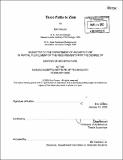| dc.contributor.advisor | Julian Beinart. | en_US |
| dc.contributor.author | Orozco, Eric, 1972- | en_US |
| dc.contributor.other | Massachusetts Institute of Technology. Dept. of Architecture. | en_US |
| dc.date.accessioned | 2006-03-24T18:31:50Z | |
| dc.date.available | 2006-03-24T18:31:50Z | |
| dc.date.copyright | 2005 | en_US |
| dc.date.issued | 2005 | en_US |
| dc.identifier.uri | http://hdl.handle.net/1721.1/30223 | |
| dc.description | Thesis (M. Arch.)--Massachusetts Institute of Technology, Dept. of Architecture, 2005. | en_US |
| dc.description | Includes bibliographical references (p. 69-71). | en_US |
| dc.description.abstract | This thesis project pursues the strategies to create urban design interventions that preserve and encourage multi-religious harmony in the contested sacred topography of Jerusalem. First, I observed the environmental and social qualities of religious coexistence by studying a pilgrimage site in Jerusalem currently shared by groups from the three monotheistic faiths, the Masjid al-Nabi Da'ud (the Mosque of the Prophet David) on Jerusalem's present-day Mt. Zion district, which is adjacent to the southern wall of the Old City. I then proposed to transform the neighborhood surrounding the pilgrimage complex by honoring the observed dynamics of coexistence, in an attempt to create a harmonious, multi-religious space in Jerusalem's sacred landscape. My intention is to create a pluralistic public sphere that serves to promote dialogue and reconciliation between the adherents of the three Abrahamic traditions. Such a place of religious harmony, to borrow the words of Louis Kahn, will present an urban environment that can serve as "a place of the example". The new district will serve as the headquarters and residency of an institution for ecumenical dialogue called the Nathan Foundation for Monotheism, which will be run by a board made up of members of the three different traditions (including the current religious parities dwelling on Mt. Zion) and partner initially with the Open Society Institute and Soros Foundations Network. In the spirit of the virtue of "hospitality", traditionally associated with Abraham, the center of the Nathan Foundation will house venues for research, exhibition, celebration and worship for each of the three faiths. | en_US |
| dc.description.abstract | (cont.) The new district will develop along a public promenade offering dramatic views of Jerusalem from one of its highest promontories. I will attempt to induce, in the pilgrim and inhabitant, a sense of wandering between cultures and faiths, an experience that will help reconstitute, with the aid of Jerusalem's religious topography, something of that reflective journeying of Abraham through the cosmopolitan swath of the Fertile Crescent. | en_US |
| dc.description.statementofresponsibility | by Eric Orozco. | en_US |
| dc.format.extent | 71 p. | en_US |
| dc.format.extent | 8885223 bytes | |
| dc.format.extent | 8892471 bytes | |
| dc.format.mimetype | application/pdf | |
| dc.format.mimetype | application/pdf | |
| dc.language.iso | eng | en_US |
| dc.publisher | Massachusetts Institute of Technology | en_US |
| dc.rights | M.I.T. theses are protected by copyright. They may be viewed from this source for any purpose, but reproduction or distribution in any format is prohibited without written permission. See provided URL for inquiries about permission. | en_US |
| dc.rights.uri | http://dspace.mit.edu/handle/1721.1/7582 | |
| dc.subject | Architecture. | en_US |
| dc.title | Three paths to Zion | en_US |
| dc.title.alternative | 3 paths to Zion | en_US |
| dc.type | Thesis | en_US |
| dc.description.degree | M.Arch. | en_US |
| dc.contributor.department | Massachusetts Institute of Technology. Department of Architecture | |
| dc.identifier.oclc | 60803413 | en_US |
